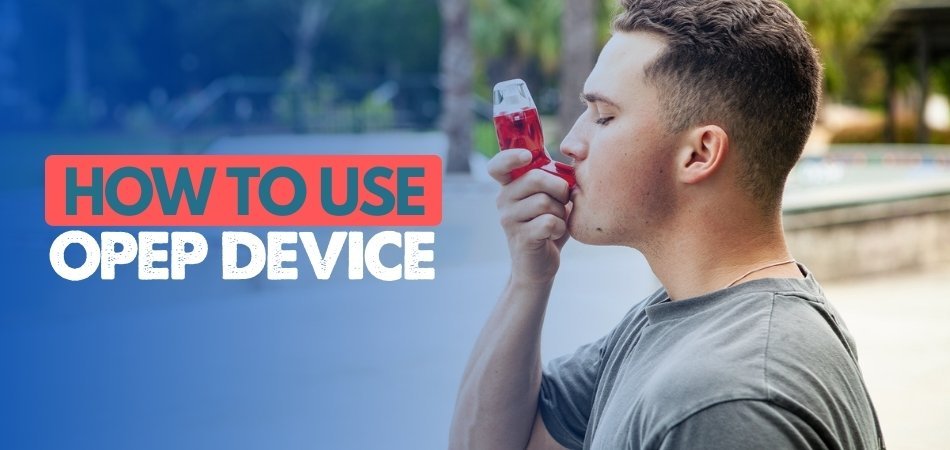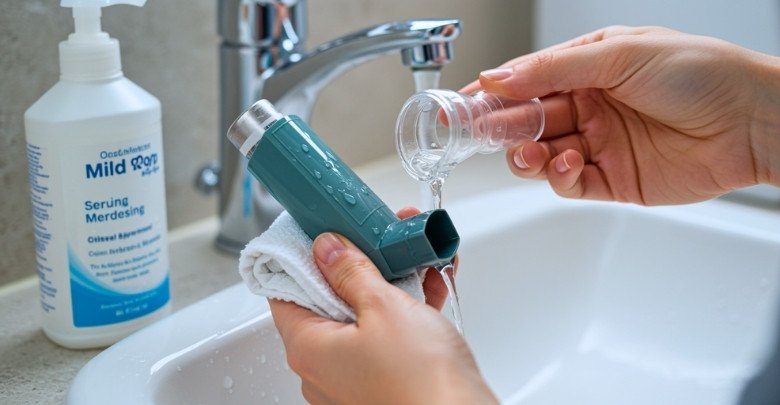It’s important to take care of your lungs, especially if you have asthma or cystic fibrosis. One tool that helps is the OPEP device. OPEP stands for Oscillating Positive Expiratory Pressure. It’s a small device that helps move mucus out of your lungs, so you can breathe better. It’s easy to use and safe for daily use at home.
So, how to use OPEP device the right way?
Start by washing your hands and sitting in a relaxed position. Set the resistance on the device. Place your lips tightly around the mouthpiece. Breathe in deeply, hold your breath for 2 to 5 seconds, then breathe out slowly through the device. Keep your cheeks firm. Do this 10–20 times, then huff and cough to clear mucus.
Keep reading to learn more tips and how to clean it!
How to Use OPEP Device?
Using an OPEP device helps clear mucus from your lungs and makes breathing easier. It is helpful for people with lung problems like COPD, asthma, or cystic fibrosis. To get the best results and stay safe during treatment, follow the steps below:

Step 1: Talk to Your Doctor First
Before you begin, make sure the device is right for your condition. Your doctor will tell you how many times to use it each day. Most people use it two to four times daily. Also, ask if any special settings or angles are needed for your model.
Step 2: Check and Set Up the Device
Look at the device and put it together if needed. Attach the mouthpiece firmly and check that nothing is broken or blocked. If you’re using a device like AirPhysio, make sure the internal ball and valve can move freely. Finally, set the resistance dial to a low level before you begin.
Step 3: Sit in the Right Position
Sit up straight with your feet flat on the floor. Relax your shoulders and keep your back straight. Some devices need to be held straight or at a tilt—check your user guide. Lean forward a little if your doctor told you to.
Step 4: Take a Deep Breath In
Breathe in slowly through your nose and fill your lungs. This should take about two or three seconds. Hold your breath for a few seconds to help air reach the mucus. This helps loosen the mucus in your lungs.
Step 5: Blow Out Steadily
Place your lips firmly around the mouthpiece. Breathe out slowly and steadily for three to four seconds. Try not to puff out your cheeks. You should feel a gentle vibration or flutter in your chest.
Step 6: Do Several Breathing Cycles
Repeat the breathing step about 10 to 15 times. This gives your lungs enough pressure to move the mucus. Take your time and rest a little if needed. After each set, get ready to clear your lungs.
Step 7: Use a Huff Cough
After one full cycle, do a huff cough to push mucus out. This means you take a breath in and then breathe out fast like saying “ha.” Don’t cough hard or dry. It should feel like blowing warm air onto glass.
Step 8: Adjust the Resistance if Needed
If mucus does not come out, try turning the resistance dial up a bit. Do not make it too hard, and stop if you feel dizzy. Take slow, easy breaths until you feel better. Your lungs may need time to get used to the pressure.
Step 9: Clean the Device Every Day
Take apart the device after using it. Wash all the parts with warm water and soap, then let them air dry. Every week, disinfect the device by following the maker’s instructions. Keeping it clean helps stop infections.
Step 10: Keep Track of How You’re Doing
Write down how much mucus you clear each time. Notice if the color or thickness changes. If you see anything unusual, call your doctor. This helps you and your doctor manage your lung health better.
Common Mistakes to Avoid When Using the Device
You can breathe better when you use an OPEP device. But if you don’t use it the right way, it won’t work well. Some simple mistakes can stop the device from doing its job. Follow these tips to get the best results every time.
- Not Taking Deep Breaths First: If you take short breaths, the air won’t go deep enough, and the mucus will stay stuck inside your lungs.
- Holding the Device the Wrong Way: You need to hold it straight or at the right angle, or it won’t make good vibrations in your chest.
- Letting Your Cheeks Puff Out: When your cheeks puff out, the air loses pressure, and the device won’t work as well to move the mucus.
- Blowing Out Too Fast or Too Hard: Breathing out too fast can make you feel dizzy and stop the device from making the chest shake like it should.
- Skipping the Huff Cough After Use: If you don’t do a huff cough, the mucus won’t come out and can stay in your lungs, causing more problems.
- Not Using the Device Often Enough: Using the device less than your doctor says will make it harder to clear your lungs and feel better over time.
- Forgetting to Clean the Device: If the device is dirty, it can carry germs and won’t work well. Clean it every day to keep it safe.
- Turning the Resistance Too High: Making it too strong too soon can be hard on your lungs and make it harder to breathe out smoothly.
What Makes the AirPhysio a Good OPEP Device?
Breathing problems can make everyday things feel hard and tiring. That’s where a simple tool like AirPhysio can help. If you’re looking for something easy to use and good for your lungs, it’s worth learning about. Before you decide, let’s look at what makes it special.

Simple to Use
AirPhysio doesn’t have any wires, batteries, or confusing parts. You just breathe in and out through it, and that’s it. It’s made for people of all ages, so learning to use it is quick. Once you try it a few times, it starts to feel normal. Even beginners can get used to it without needing help every time.
Good Build Quality
The device is made with strong, safe materials that last a long time. It doesn’t feel cheap or weak in your hands. You can drop it by mistake, and it still works fine. It also doesn’t rust or break easily if you clean it right. That means you won’t have to keep buying a new one.
Portable and Handy
You can carry AirPhysio in your school bag, sports bag, or even in your pocket. It’s not big or heavy, so it fits almost anywhere. If you go out for a day, you won’t have trouble bringing it with you. Using it outside the house is just as easy as at home. That makes staying on track with breathing exercises simple.
No Need for Medicine
One cool thing is that it doesn’t use any medicine to help you breathe better. It works with your body’s own air. That means you don’t have to worry about side effects or taking pills. It’s a natural way to clear mucus from your lungs. Many people like it because of that.
Works for Many Conditions
Whether you have asthma, bronchitis, or just feel stuffed up, AirPhysio can help. It pushes air back into your lungs, which helps move out the mucus. That makes breathing easier, and your chest feels lighter. People with different breathing problems find it useful. You don’t need a special condition to try it.
Easy to Clean
After using it, you can take it apart and clean it in warm, soapy water. It doesn’t have tiny parts that are hard to reach. You don’t need any special tools or cleaners. Just rinse, dry, and put it back together. This helps it stay clean and safe for everyday use.
Gets Results Over Time
You may not feel better right away, but using AirPhysio often can help you breathe easier over time. It helps you clear your lungs little by little each day. The more you use it, the more your breathing improves. Many people say they start feeling lighter and less blocked. Just keep using it like your doctor says.
How Often Should You Use the OPEP Device?
Most people should use the OPEP device twice a day-once in the morning and once at night. Each time, you should use it for about 10 to 20 minutes to help keep your lungs clear. If you are sick or have more mucus than usual, you can use it more often. In that case, try to use it three or four times a day to feel better faster.
You should take 10 to 20 breaths through the device during each session, then do two or three huff coughs. During sickness or heavy mucus, using a breathing trainer device like the OPEP can really help clear your chest. Always follow your doctor’s advice on how often to use it, since every person is different. Using it the right way can help you breathe better and keep your lungs healthy over time.
Tips to Get the Best Results From Your OPEP Therapy
OPEP therapy can help clear your lungs and improve your breathing when done the right way. Using it daily in the correct steps makes a big difference. Small changes in how you use the device can give better results. To make the most of your therapy, follow the following tips:
- Sit in a Proper Position: Keep your back straight and shoulders relaxed, so the air moves better and the pressure stays steady through your chest.
- Breathe Slowly and Deeply: Take slow breaths in through your nose to fill your lungs, helping air reach deeper to loosen mucus buildup.
- Hold Your Breath a Bit: After breathing in, hold it for a few seconds to let the air push behind the mucus and move it up.
- Keep Your Cheeks Firm: Use your hands or muscles to stop your cheeks from puffing, which helps keep strong pressure inside the lungs.
- Exhale at a Steady Pace: Don’t blow too hard or too fast—just steady breathing helps the device create the right chest vibrations each time.
- Do a Huff Cough After Sets: Clear your lungs by doing a few strong huff coughs after breathing cycles, so the mucus leaves your airways fully.
- Clean Your Device Daily: Wash your device in warm, soapy water after each use to keep it safe and working well without blockages.
Cleaning and Taking Care of Your OPEP Device
Taking care of your OPEP device is just as important as using it the right way. If it’s not clean, it might not work properly or could even make you feel worse. Keeping it in good shape doesn’t take long and is easy to do. Let’s look at how you can keep your device clean and safe every day.

Daily Rinse
After each use, take the device apart carefully and rinse all the parts under warm water. This helps wash away any leftover mucus or spit that can block the airflow. Make sure the water runs through all the small parts. A quick rinse each time keeps the device fresh and working well.
Use Mild Soap
Warm, soapy water is perfect for cleaning your OPEP device. You don’t need any strong or fancy cleaners. Just use mild soap that doesn’t leave behind a strong smell or harmful stuff. Scrub gently to remove anything sticky, then rinse it well with clean water.
Drying the Parts
After washing, place the parts on a clean towel and let them air dry. Don’t wipe them with a dirty cloth or stuff them into a drawer while still wet. Moisture can make germs grow, and that’s not good for your lungs. Waiting for everything to dry fully keeps the device safe to use again.
Weekly Deep Clean
Once a week, do a deeper clean by soaking the parts in warm water with a bit of vinegar. This helps remove extra buildup and makes sure everything stays extra clean. After soaking for about 10–15 minutes, rinse all the parts again with clean water. This kind of cleaning is great for staying ahead of germs.
Check for Damage
Always check your device for cracks, loose parts, or anything that doesn’t feel right. Even a small crack can stop it from working properly. If something feels off, talk to your doctor or get help from an adult. You want your device in perfect shape every time you use it.
Storage Tips
After cleaning AirPhysio or any OPEP device, keep it in a clean, dry place away from dust or heat. A small box or container works great for storing it safely. Don’t leave it lying around on a shelf or near the sink. Clean storage means your device stays ready for the next use.
Stick to a Routine
Try to clean your device at the same time each day, like right after your therapy session. Making it a habit helps you remember and keeps things simple. You won’t have to guess if it’s clean or not. A regular routine makes a big difference in how well your device works.
FAQs About Using the OPEP Device
Using an OPEP device may seem tricky at first, but it becomes easy with the right help. Here are some common questions that many people ask when starting out. These answers will help you feel more confident and clear.
Can I Use the OPEP Device While Lying Down?
No, it’s best to sit upright when using the OPEP device. Sitting helps your lungs open up better, making the device more effective. Lying down may reduce pressure and stop proper mucus movement. Always keep your back straight during use.
Should I Use the Device Before or After Meals?
Try using the OPEP device before meals or wait at least an hour after eating. Using it right after a meal may cause discomfort or make you feel like coughing too much. A clear stomach helps you breathe easier during therapy.
Is It Okay to Share My Device With Someone Else?
No, sharing your OPEP device is not safe or hygienic. Even if it looks clean, it can carry germs that spread illness. Each person should have their own device to stay healthy and avoid infections. Always keep it for personal use.
What If I Can’t Feel the Chest Vibrations?
If you don’t feel the chest vibrations, check your breathing technique and the resistance setting. You may need to adjust how strongly you breathe out. Make sure your cheeks stay firm. If you still feel nothing, ask your doctor for advice.
Do I Still Need to Cough During the Session?
Yes, coughing is important during and after using the device. It helps remove mucus that gets loosened by the pressure. Use a “huff cough” instead of a dry one. This makes it easier and gentler on your chest and throat.
Can Children Use the OPEP Device Safely?
Yes, children can use it, but they should always have help or supervision. Their doctor may suggest a smaller device or lower resistance. Make sure they understand the steps. It’s important they use the device calmly and not forcefully.
How Long Should I Wait Between Sessions?
You should wait several hours between sessions to give your lungs time to recover. If using it twice a day, morning and evening work well. During sickness, space out extra sessions evenly. Always follow your doctor’s timing if unsure.
What Should I Do If I Feel Dizzy While Using It?
If you feel dizzy, stop using the device and rest. Take slow, gentle breaths to help you feel better. You might be breathing out too fast or too hard. Try again later with a softer breath and adjust the resistance if needed.
Closing Remarks
When you use the right tools, such as an OPEP device, you can take good care of your lungs. If you follow the steps properly and clean it every day, it can really help you breathe better. Learning how to use OPEP device the right way makes sure it works well for you.
Doing things like sitting straight, breathing slowly, and doing huff coughs after each set makes a big difference. Also, don’t forget to ask your doctor if you’re not sure about something. When you use the device the right way, you’ll start to feel better and breathe easier over time.






